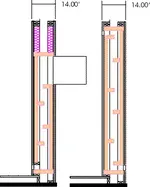ENIGMACODE
New member
Hello? 
In regard to my last thread here:
http://www.homerecording.com/bbs/showthread.php?t=125501
I really do appreciate all of your comments ....
I was just looking for perhaps one final blessing in regard to my approach that I outlined in my last thread to the problem of adapting a conventional non-ducted air conditioner in a small all-purpose rehearsal room ....
In the past I gathered up all of your valuable contributions, and took heed as I implemented some of your points and precautions in regard to construction.
To recap:
The room is simply an all-purpose rehearsal room built within the basement of a tiny row home...
The room is floated over concrete with FREE standing walls - NO direct contact with the existing structure.. Drywall will be 2 layers of 1/2" on the cieling, and 5/8" on the walls - I'm going to follow Rod Gervais's tips in regard to overlapping, and caulking etc.. All and all the construction is generally acoustically 'sound'
What I'm asking:
Because of budget and space limitations, I CANNOT justify the expense of a ducted system ....
Sooooo - Since I'll have to CUT through 2 outside walls in the rear for a conventional wall unit, I will take EVERY precaution to design #2 SEALING Gasketed Doors, that will be CLOSED when the AC unit is NOT operating... AND YES I CAN LIVE WITH THIS ....
Sooooo with ALL of this said, am I still on track?
Will this 'Cut Out' have a tendency to 'NEGATE' all of my OTHER efforts to design an acoustically tight room???? OR will the project STILL be worth the effort (given all of my precautions?)
Best Regards
Michael Fraticelli
rocknroll@ucwphilly.rr.com

In regard to my last thread here:
http://www.homerecording.com/bbs/showthread.php?t=125501
I really do appreciate all of your comments ....
I was just looking for perhaps one final blessing in regard to my approach that I outlined in my last thread to the problem of adapting a conventional non-ducted air conditioner in a small all-purpose rehearsal room ....
In the past I gathered up all of your valuable contributions, and took heed as I implemented some of your points and precautions in regard to construction.
To recap:
The room is simply an all-purpose rehearsal room built within the basement of a tiny row home...
The room is floated over concrete with FREE standing walls - NO direct contact with the existing structure.. Drywall will be 2 layers of 1/2" on the cieling, and 5/8" on the walls - I'm going to follow Rod Gervais's tips in regard to overlapping, and caulking etc.. All and all the construction is generally acoustically 'sound'
What I'm asking:
Because of budget and space limitations, I CANNOT justify the expense of a ducted system ....
Sooooo - Since I'll have to CUT through 2 outside walls in the rear for a conventional wall unit, I will take EVERY precaution to design #2 SEALING Gasketed Doors, that will be CLOSED when the AC unit is NOT operating... AND YES I CAN LIVE WITH THIS ....

Sooooo with ALL of this said, am I still on track?
Will this 'Cut Out' have a tendency to 'NEGATE' all of my OTHER efforts to design an acoustically tight room???? OR will the project STILL be worth the effort (given all of my precautions?)
Best Regards
Michael Fraticelli
rocknroll@ucwphilly.rr.com



 Hey Michael
Hey Michael 
